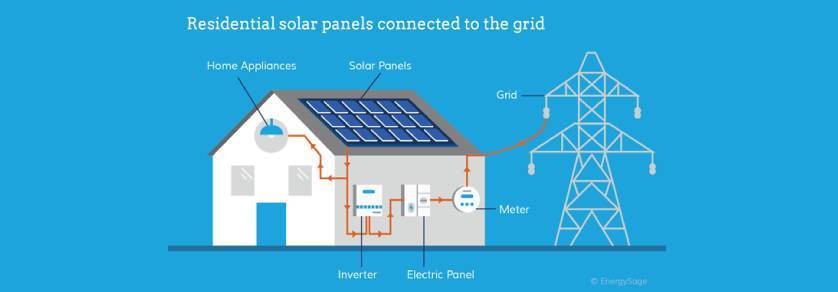How Does a Solar System Generate Electricity?

Find Out How Your Solar Panels Work
Thanks to solar panels, humankind can now harness power from the sun. The first ever practical solar cell was invented by scientists at Bell Telephone Labs. In 1954, they demonstrated to the world that sunlight can be turned into electricity. This milestone in renewable energy later led to the development of modern photovoltaic solar panels. It also started the widespread manufacture of solar cell energy systems, providing both financial and environmental benefits.
4 Components of a Solar Panel System
The conversion of the sun’s radiation into electricity involves high technical complexity. Before we delve deeper into the step by step process, you should understand the different components that make up a solar system. A solar photovoltaic system relies on four main components. They work hand-in-hand to produce electricity, convert DC power into useable AC form, store excess electricity and maintain safety.
1. Solar Panels
Solar panels or modules are considered to be the core of the system. Each panel contains photovoltaic cells - positive and negative film of silicon - which are laminated behind tempered glass. Their main function is to collect the sun’s energy and transform it into electricity. There are three popular solar panel types in the market today:
-
Monocrystalline Solar Panels: Characterized by their uniform dark look and rounded edges. They contain silicon of high purity making it the most expensive choice. They offer high efficiency rate and high lifetime value and are usually optimized for commercial use.
-
Polycrystalline Solar Panels: You can distinguish these panels because of their blue, speckled appearance and rough angles. They tend to be cheaper because they are made from melted raw silicon. They are quite sensitive to high temperatures leading to a lower lifespan.
-
Amorphous Silicon Solar Panels: Also called thin-films, these panels are relatively low cost because they are easy to produce. They are the most flexible type so application can be easier. The downside is that they take up a lot of space.
2. Inverter
Solar inverters are the brains of the system. When solar panels absorb energy from the sun, the output will be variable direct current (DC) which can’t be fed into commercial appliances. Inverters “invert” the DC output into useable standard alternating current (AC). There are three approaches to solar inverters.
-
String or centralized inverter: A single inverter connects your entire array of solar panels to your electrical panel. It treats a group of panels as if it were a single large panel. It is easier to install and offers a lower initial cost per peak watt price. However, if something goes wrong with the system, it may be more difficult to troubleshoot.
-
Micro-inverters: Micro-inverters are installed on each individual panel so they cost more per peak watt. But because of this feature, performance issues are minimized. In times of partial shading, the rest of the panels won’t be affected. Micro-inverters also monitor the performance of individual solar panels through ‘power point tracking.’
-
Power optimizers: This technology is a compromise between the standard string and micro-inverter. Like micro-inverters, power optimizers are attached to each panel. However, instead of converting DC into AC on the roof, they go through a centralized inverter. They are a bit pricier than string inverter systems but more affordable than micro-inverter systems.
3. Racking and Mounting System
A well-engineered racking and mounting system is necessary to secure solar panels to a roof or to the ground. They also allow installers to position the panels at the right angle so they can perform at their best. Most systems are made of aluminium with stainless steel hardware and are designed to accommodate different types of solar modules.
For maximum performance, solar panels should be installed facing south at an angle between 30 and 45 degrees (depending on your home’s distance from the equator). Panels facing east or west could still work but will generate 10 to 20 percent less electricity. Homeowners have two options for mounting solar panels—fixed mounts (panels remain stationary) and track mounts, where panels follow the direction of the sun, but this is only available for panels installed on the ground.
4. Performance Monitoring Systems
A performance monitoring system lets you track the amount of electricity your solar system produces on an hourly basis. Its basic function is to help you identify any performance issues within your solar system. In doing so, you can ensure maximum electricity production. Installers may charge extra for a monitoring system but it can provide significant value down the road.
-
On-site monitoring: The monitoring device is physically located on your property and records the amount of electricity produced.
-
Remote monitoring: Your solar PV system transmits its performance data to a monitoring service that you can access online or with a mobile device.
How Do Solar Systems Produce Energy?
With a solar system, the process of generating electricity begins with the modules. When sunlight hits a silicon crystal, the electrons inside of it begin to get excited, causing them to move freely inside the cells. Eventually, all the motion charges them up until they produce an electrical current. Since each photovoltaic cell is made up of silicon, a semi-conducting material, it sustains the constant electron imbalances until enough electrical current is generated.
Other components of the photovoltaic cell turn the electrons into usable power. Meanwhile, metal conductive plates found on the sides of the cell collect the electricity and transfer them to wires. At that point, it flows as standard electricity for your home.



